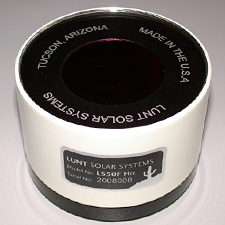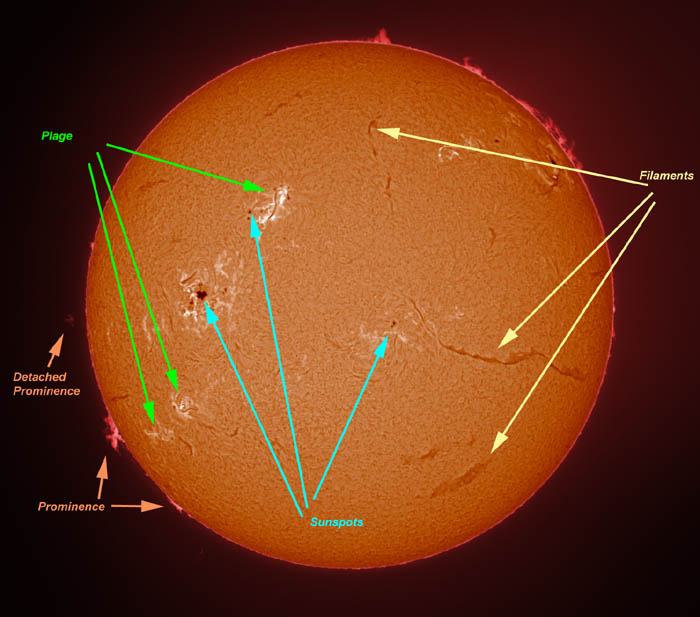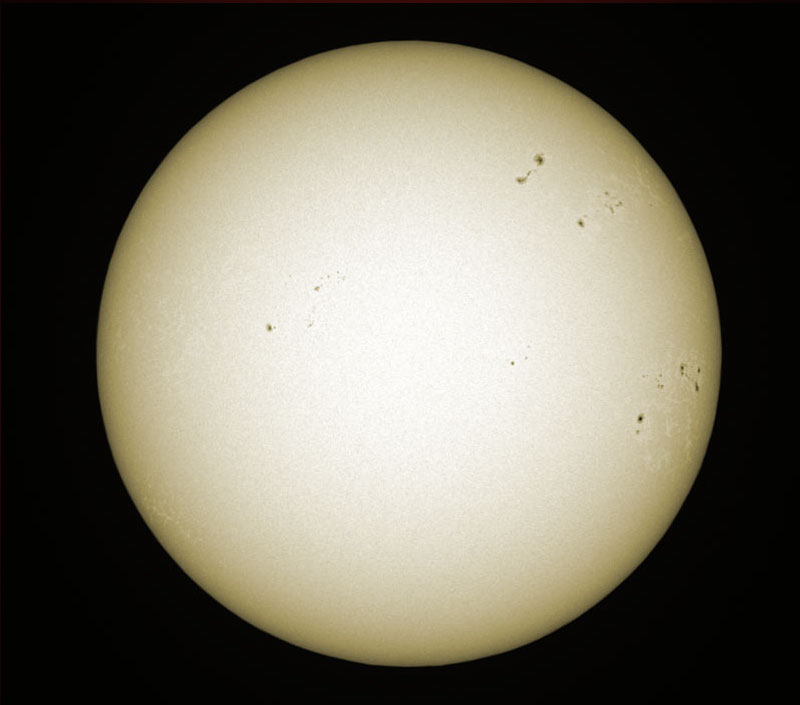Advanced Telescope Supplies
Australia's Premier CCD and Astro-Imaging Experts


Roll your mouse over the image below to see what a difference a Hydrogen-Alpha filter can make!
To obtain an image of the sun as in the image above you need to use a very narrow band Hydrogen Alpha filter.
All Lunt filters have a sub angstrom bandwidth (0.8 to 0.6 Angstrom depending upon the model).Traditionally, these filters are notoriously difficult manufacture (or even to obtain), and historically have been very expensive.
While there are less expensive "prominence" filter alternatives, these filter types do not show any fine solar disk detail, They also have less image contrast.
Lunt Solar use an Etalon based filter design that employs ultra hard coatings that, unlike other H-Alpha Filter designs, will not degrade with time. These filters block much of the Sun's light and reveal the spectacular surface and prominence detail visible only in the narrow Hydrogen Alpha range of the Sun's spectrum.
Lunt filters are very easy to use.
The etalon is simply attached to the objective end of the telescope (using your own or a Lunt adapter) and the supplied blocking filter is used at the eyepiece end. No wires, heaters or power is required. The image is bright and does not require any special measures (e.g. a dark cloth over the observers head!) to deliver superb prominence and disk details.
Many amateur astronomers question the cost of a filter that may cost more than their entire telescope. Part of the reason is their telescope is unlikely to have been made quite so accurately. Most telescopes deliver "1/4 wave performance". Lunt etalons are constructed from plates on which coatings are deposited and the parallelism of the intervening gap have to be fabricated to less than one-hundredth of the wavelength of light! In physical units, no part of the structure deviates from two perfect planes by more than 0.000005mm or 0.0000002 inches! Or to put it another way, about 25x finer than a high quality "diffraction limited" telescope.
Lunt Solar offer a range of high quality H-Alpha filters fromfrom modest to large apertures with prices ranging from around $A700 to $15,000. No matter which filter you choose however, the view is always superb.
Due to long delivery times, please call (02) 95411676 or email: sales "at" atscope.com.au for pricing.
Solar Observing Glossary
Many amateur astronomers have seen filtered "white light" images of the sun though Neutral Density solar filters. The view is some what static, and changes, if any, are slow and generally linked to the rotation of the sun. If anything the view is reminiscent of the moon ("wow" at first, but a little "ho-hum" after the 100th view). Hydrogen Alpha viewing of our nearest star is much more dynamic. Features can literally change over a few minutes (this is very radical for deep sky observers...where objects rarely seen to change in decades!). To help observers classify these features, we have included the following glossary. Suffice to say the H-Alpha view of our sun is simply amazing. Filaments prominences and plage are nearly always visible!

CHROMOSPHERIC NETWORK An constant patchy network of long thin sinuous chains of tiny low contrast brighter points called Filigree (also found in plages) extending over much of the solar disk in H-Alpha. These points, or "network elements", often have darker spicules or short fibrils sticking out of, or running past them (part of the fine disk detail known as the Dark Mottles), making the actual network harder to see.
ELLERMAN BOMBS Bright transient pin-points of light (usually last less than 5 minutes), most often found in Emerging Flux Regions or on the edges of sunspots where the magnetic field is breaking the surface. They are best seen in the wings of H-alpha (nearly 5 Angstroms wide).
EMERGING FLUX REGION (EFR) A magnetic area on the sun where "flux tube" is surfacing on the disk, eventually producing a bipolar sunspot group. In H-alpha, EFRs usually appear as a small oval area of bright plage (typically about 7000 km across) often containing a series of short-lived narrow fibrils (Arch Filament System (AFS)) running roughly from one end of the dipole to the other. Each pole of an EFR is often marked by pores or small developing sunspots. Surges or even small solar flares can sometimes occur in EFRs.
EPHEMERAL REGIONS (ER's) Small magnetic dipoles with lifetimes of about a day which contain no sunspots. Ephemeral regions can develop anywhere on the sun, but are more common at mid and lower solar latitudes. They appear as small brighter elements in the chromospheric network but are fainter than active region plage. They also can occasionally produce small surges or sub flares.
FACULAE Patchy white light blotches in the photosphere (not visible in H-alpha), usually seen mainly towards the limb due to limb darkening. Faculae are most often found near active regions or where one is about to form, and can last well after the sunspots in the active region have decayed (best seen in blue light).
FIBRILS Small fine filament-like darker features which tend to run along magnetic field lines. Often, they are connected to or part of the structure of larger filaments, curving into or running along the filament's main axis.
FIELD TRANSITION ARCHES (FTA) Filament-like fibrils which cross the polarity inversion line (a line marking the halfway point between two opposite polarity areas) of a bipolar magnetic region. Unlike AFS fibrils, they show little or no Doppler shifts and tend to be rather thin and not very dark. FTA tend to arch directly between localized areas of opposite magnetic polarity, and often mark magnetically stable regions.
FILAMENTS Prominences seen against the face of the sun, appearing as long narrow dark streamers or diffuse complex dark areas in H-alpha light. Filaments often mark areas of magnetic shearing (see Prominences).
GRANULATION Tiny convective cell structures visible in white light ("rice grains"), best seen in apertures over three inches, and in green light. Each cell consists of a brighter polygonal area of hot rising gas typically about 1100 km across, and a cooler edge or "channel" of descending gas about 230 km wide.
MORETON WAVE A shock wave seen on the chromosphere that is occasionally seen expanding outward from large impulsive solar flares, moving over the surface at about 1000 km/sec. It usually appears as a slowly moving diffuse arc of brightening in the centerline of H-alpha, or as a faint diffuse slightly darker arc in the blue wing.
PROMINENCES H-Alpha emission features that resemble "flames" projecting beyond the edge of the sun, consisting of complex clouds or streamers of gas above or in the chromosphere. They generally come in two broad classes: Active (limb flares, surges, sprays, loops), and Quiescent (Quiet Region Filaments, Active Region Filaments).
PLAGE Patchy brightenings on the solar disk seen in H-Alpha light, usually found in or near active regions, which can last for several days. Plage is irregular in shape and variable in brightness, marking areas of nearly vertical emerging or reconnecting magnetic field lines (from French word for "beach" with the "a" being a short one).
PORES Tiny darker spots under 2500 km in size, often having fairly short lifetimes. Pores occasionally form where several granulation channels meet and can sometimes precede the development of sunspots.
RECONNECTION A realignment of magnetic fields, where an area of one magnetic polarity breaks earlier links, and connects with the nearest region of opposite polarity. On the sun, this often happens when a new magnetic dipole emerges near another pre-existing one. For example, if the north pole of the new dipole emerges close to the south pole of the old dipole, the lines of force may reconnect these two nearby poles configuring them as a new lower energy dipole and releasing energy, often in the form of plage brightening or a solar flare.
SOLAR FLARE Extremely bright moderate to large transient emission feature lasting from a few minutes to over four hours. Flares are a rapid and violent release of energy in the chromosphere due to extreme magnetic field stress and can occasionally result in material leaving the sun in the form of a Coronal Mass Ejection (CME).
SPICULES Small jets of gas under 10,000 km long, usually seen as a mass of tiny brighter spike-like features at the limb or as tiny darker spikes coming out of network elements, but are not usually seen over bright plage.
SPRAY A transient prominence formed by the explosion of pre-flare elevated material which sends debris flying off in many directions. Usually produced only by the most violent flares, as overlying filaments are blown away.
SUNSPOT Dark long-lived photospheric feature, typically from 2500 to 50,000 km in size. Moderate to large spots usually consist of a darker central region (umbra) and a lighter halo consisting of many short fine fibrils (penumbra). Sunspots have strong concentrated magnetic fields which tend to inhibit energy transfer from below, making them at the center about 2500 degrees K cooler than the photosphere. In the Umbra, the fields tend to be nearly vertical in orientation while in the penumbra, the magnetic fields become more horizontal.
SURGE A transient prominence produced by flares or very active regions, appearing as a moderate to large collimated jet of gas rising up from the surface. Surge ejected gas will often fall or draw back onto the sun tending to follow magnetic field lines, while at other times it will rise and disperse, fading from view.
"WINGS" OF H-ALPHA Doppler-shifted features of the sun can be viewed at wavelengths slightly off of 6562.8 Angstroms (up to +/- 2 Angstroms). The "blue" wing is a shorter wavelength and the "red" is on the longer side.
Lunt Solar have quite long delivery times and pricing will depend on $A to $US at importation.
